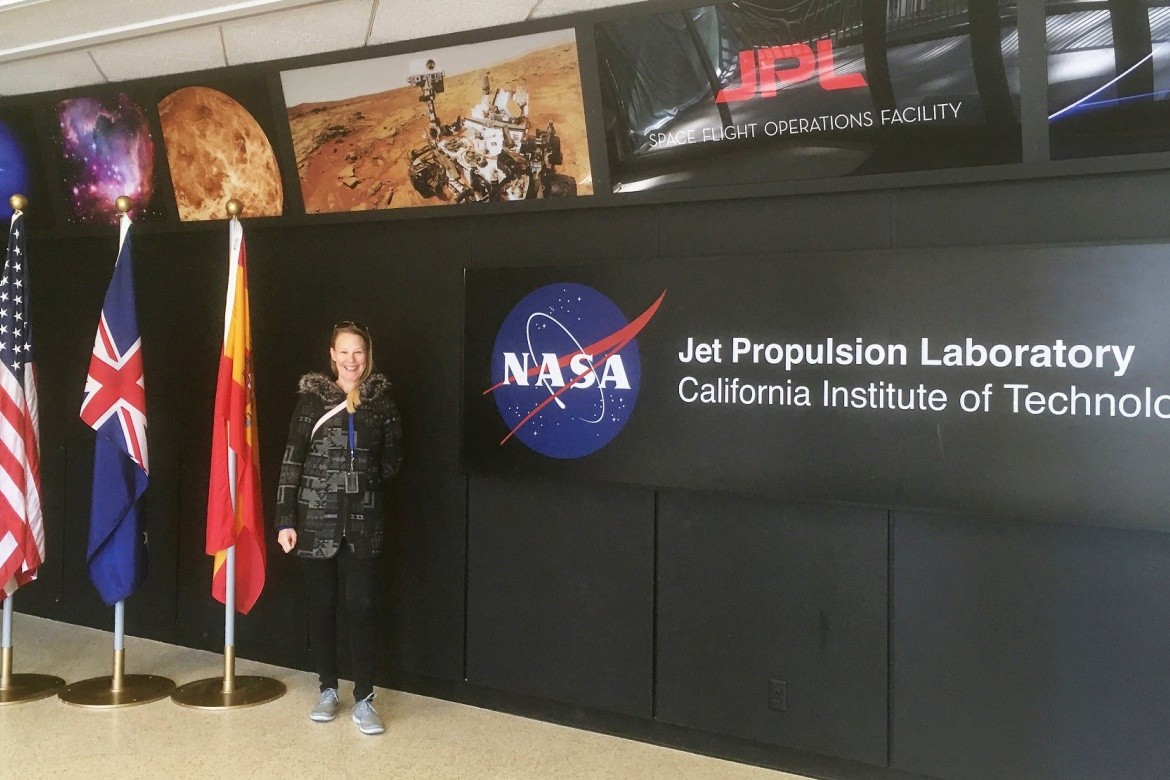Out of this world

Mount Holyoke alum Sara Schnadt ’92, an artist and software systems architect for NASA, is proof that art and technology can be deeply intertwined.
By Jeremy Gantz
Mars wasn’t in Sara Schnadt’s career plan. While at Mount Holyoke College, she put the liberal arts ideal into action, taking math, physics and various studio arts classes. After Schnadt graduated at age 19, in 1992, with a degree in fine arts, she decided to pursue a career as an artist. “I felt I had to be one thing,” she said. “I don’t know why I thought that, but I did.”
The truth has a way of coming out, though. Over the past 25 years, Schnadt’s installations and performance art explores technology innovation and its impacts on culture and community. Many of her pieces involve data visualization, projection and spatial illusions, attempting to make the virtual tangible.
In an exhibit at Chicago’s Museum of Contemporary Art, titled “Connectivity,” for example, Schnadt constructed a network of string, wire and other found and donated objects to visually represent the World Wide Web and its distributed nature.
All the while, Schnadt was discovering a talent and passion for information systems architecture. She helped design databases and software tools for arts and civic organizations.
Then, in 2016, she joined an aerospace startup in San Francisco that was launching a fleet of satellites to track climate change in real time. The work was challenging and the tech world was male-dominated — but Schnadt credits her formative Mount Holyoke experience with giving her the confidence to grow and pivot throughout her career.
“My sense of what was possible was just not gendered. It’s like, of course I can do this,” she said. “Why would you even be looking at me funny?”
By 2017, Schnadt had been recruited to NASA’s Jet Propulsion Laboratory, a federally funded research and development center that’s affiliated with Caltech.
While in JPL’s human-centered design group, where she designed a software system architecture to support planning and simulation models for the Europa Clipper mission, which will orbit the Jupiter moon Europa, she had a eureka moment.
“I finally discovered that my fascination with technology and the things that were most core to my art practice were actually the same,” Schnadt said. It all hinges on what she calls “complex spatial thinking.”
“I have an aptitude for larger-scale design work,” she said. “It’s like the difference between someone who designs furniture and someone who designs houses.”
The creative process she had used for years to develop art installations, it turned out, was very similar to the process she found herself using as she began specializing in software system architecture for the scientific and operations teams supporting JPL missions.
Since 2019, Schnadt has been working on the Mars 2020 mission. It seeks signs of ancient microbial life via the Perseverance rover, which landed on Mars’ Jezero crater in February.
Architecture is an apt metaphor for Schnadt’s role on the mission. With the job title of “ground data system human-centered design lead,” she led two large software design efforts: one to create a science intent capture architecture that helps hundreds of scientists around the world collaborate on planning and data analysis, and another to design a suite of tools that the operations team uses to coordinate their work controlling the rover from JPL headquarters in southern California.
In both cases, Schnadt collaborates with end users and software engineers, not unlike the way a home architect works to translate the needs of a client into blueprints construction contractors then turn into a functioning building. While not a software engineer herself, she knows enough coding to be able to lead technical engineering teams.
After the Perseverance’s landing last month, Schnadt is now embedded with the operations team. The goal is to see how people are using the systems she designed, so that she can improve them. While on site at JPL, as well as from home, she joins the operations and science teams in monitoring Perseverance, poring over images from the rover to learn the crater landscape it explores.
Things were already unusual on Earth, due to the COVID-19 pandemic. Working a schedule tied to Martian days (called “sols”), which are about 40 minutes longer than Earth days, is making life even more surreal for Schnadt and the Mars 2020 team since landing day.
“It’s both a privilege and a challenge working on developing a mission like this during a pandemic —nothing about our deadlines changed at all, once the global pandemic started,” she said.
While the demands of the mission have mostly crowded out her bandwidth for art in recent years, Schnadt has begun work on conceptual drawings that will set the stage for her next three-dimensional installation project. The subject: the enormous, collaborative effort required to create a mission system to send a robot to another planet.
“I have little bits of energy here and there,” she said. “But it’s inevitably going to happen.”